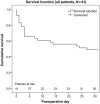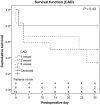Percutaneous extracorporeal life support for patients in therapy refractory cardiogenic shock: initial results of an interdisciplinary team
- PMID: 24336784
- PMCID: PMC3930215
- DOI: 10.1093/icvts/ivt505
Percutaneous extracorporeal life support for patients in therapy refractory cardiogenic shock: initial results of an interdisciplinary team
Abstract
Objectives: Therapy refractory cardiogenic shock is associated with dismal outcome. Percutaneous implantation of an extracorporeal life support (ECLS) system achieves immediate cardiopulmonary stabilization, sufficient end-organ perfusion and reduction of subsequent multiorgan failure (MOF).
Methods: Forty-one patients undergoing percutaneous ECLS implantation for cardiogenic shock from February 2012 until August 2013 were retrospectively analysed. Mean age was 52 ± 13 years, 6 (15%) were female. Mean pH values obtained before ECLS implantation were 7.15 ± 0.24, mean lactate concentration was 11.7 ± 6.4 mmol/l. Levels obtained 6 h after ECLS implantation were 7.30 ± 0.14 and 8.7 ± 5.0 mmol/l, respectively. In 23 patients (56%) cardiogenic shock resulted from an acute coronary syndrome in 13 (32%) from cardiomyopathy, in 5 (12%) from other causes. Twenty-seven (66%) had been resuscitated, in 14 (34%) implantation was performed under ongoing cardiopulmonary resuscitation (CPR). Of note, 97% of the acute coronary syndrome patients underwent percutaneous coronary intervention (PCI) either before ECLS implantation or under ECLS support. Extracorporeal life support implantation was performed on scene (Emergency Department, Cath Lab, Intensive Care Unit) by a senior cardiac surgeon and a trained perfusionist, in 8 cases (20%) in the referring hospital.
Results: Thirty-day mortality was 51% [21 patients, due to MOF (n = 14), cerebral complications (n = 6) and heart failure (n = 1)]. Logistic regression analysis identified 6-h pH values as an independent risk factor of 30-day mortality (P < 0.001, OR = 0.000, 95% CI 0.000-0.042). Neither CPR nor implantation under ongoing CPR resulted in significant differences. In 26 cases (63%), the ECLS system could be explanted, after mean support of 169 ± 67 h. Seven of these patients received cardiac surgery [ventricular assist device implantation (n = 4), heart transplantation (n = 1), other procedures (n = 2)].
Conclusions: Due to the evolution of transportable ECLS systems and percutaneous techniques implantation on scene is feasible. Extracorporeal life support may serve as a bridge-to-decision and bridge-to-treatment device. Neurological evaluation before ventricular assist device implantation and PCI under stable conditions are possible. Despite substantial mortality, ECLS implantation in selected patients by an experienced team offers additional support to conventional therapy as well as CPR and allows survival in patients that otherwise most likely would have died. This concept has to be implemented in cardiac survival networks in the future.
Keywords: Cardiogenic shock; Cardiomyopathy; Extracorporeal life support; Myocardial infarction.
Figures




References
-
- Nolan JP, Hazinski MF, Billi JE, Boettiger BW, Bossaert L, de Caen AR, et al. Part 1: executive summary: 2010 International Consensus on Cardiopulmonary Resuscitation and Emergency Cardiovascular Care Science with Treatment Recommendations. Resuscitation. 2010;81(Suppl 1):e1–25. doi:10.1016/j.resuscitation.2010.08.002. - DOI - PMC - PubMed
-
- Thiele H, Zeymer U, Neumann FJ, Ferenc M, Olbrich HG, Hausleiter J, et al. Intra-aortic balloon counterpulsation in acute myocardial infarction complicated by cardiogenic shock (IABP-SHOCK II): final 12 month results of a randomised, open-label trial. Lancet. 2013 - PubMed
-
- Seyfarth M, Sibbing D, Bauer I, Frohlich G, Bott-Flugel L, Byrne R, et al. A randomized clinical trial to evaluate the safety and efficacy of a percutaneous left ventricular assist device versus intra-aortic balloon pumping for treatment of cardiogenic shock caused by myocardial infarction. J Am Coll Cardiol. 2008;52:1584–8. doi:10.1016/j.jacc.2008.05.065. - DOI - PubMed
-
- Belohlavek J, Kucera K, Jarkovsky J, Franek O, Pokorna M, Danda J, et al. Hyperinvasive approach to out-of hospital cardiac arrest using mechanical chest compression device, prehospital intraarrest cooling, extracorporeal life support and early invasive assessment compared to standard of care. A randomized parallel groups comparative study proposal. ‘Prague OHCA study. J Transl Med. 2012;10:163. doi:10.1186/1479-5876-10-163. - DOI - PMC - PubMed
-
- Beurtheret S, Mordant P, Paoletti X, Marijon E, Celermajer DS, Leger P, et al. Emergency circulatory support in refractory cardiogenic shock patients in remote institutions: a pilot study (the cardiac-RESCUE program) Eur Heart J. 2013;34:112–20. doi:10.1093/eurheartj/ehs081. - DOI - PubMed
MeSH terms
Substances
LinkOut - more resources
Full Text Sources
Other Literature Sources
Miscellaneous

